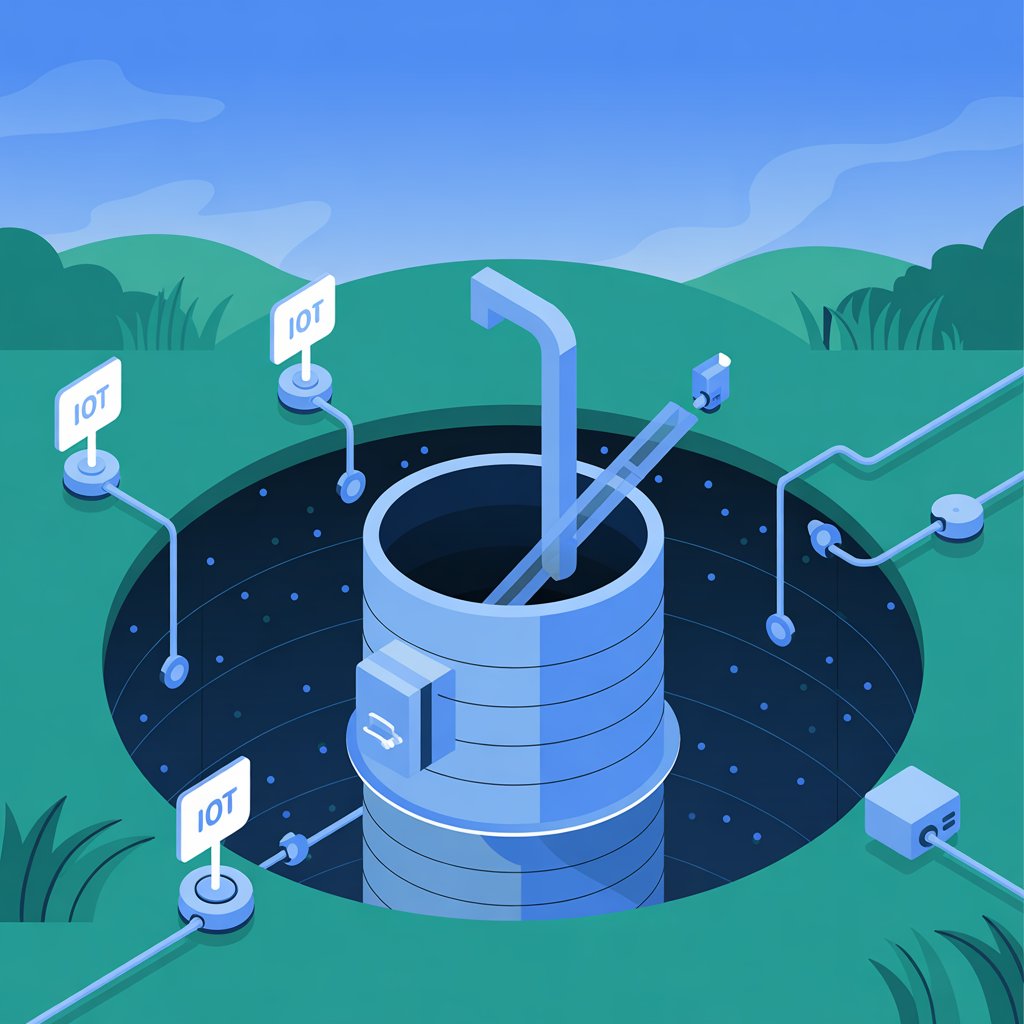Infrastructure Maintenance Transformation through Artificial Intelligence
Predictive Maintenance (PdM) based on artificial intelligence is one of the most important innovations in water infrastructure management in recent years. This technology enables a transition from reactive (repair after failure) and preventive (regular maintenance according to schedule) models to a predictive model, where service interventions are planned based on the actual condition of equipment and forecasted probability of failure.
In this article, we analyze how artificial intelligence (AI) and machine learning (ML) algorithms are revolutionizing the approach to pumping system maintenance, bringing measurable economic and operational benefits.
Research shows that implementing AI-based predictive maintenance allows for a reduction of unplanned downtime by up to 70% and extends equipment lifespan by 20-40%, while simultaneously reducing maintenance costs by 25-30%.
Foundations of AI in Predictive Maintenance
1. Types and Sources of Data
Effective predictive maintenance requires access to diverse data that can be used to monitor equipment condition and predict potential failures. For pumping systems, key data sources include:
- Operational data - pump performance parameters (flow, pressure, power, temperature)
- Vibration data - vibration measurements that may indicate mechanical problems
- Acoustic data - analysis of sounds emitted by operating equipment
- Electrical data - monitoring of current consumption, voltage, harmonics
- Historical data - records of failures, repairs, and maintenance activities
- Contextual data - environmental conditions, system load, time of day/year
Modern IoT systems and advanced sensors enable the collection of these data in real-time, creating a rich information set that can be analyzed by AI algorithms.
2. Data Processing Techniques
Raw data from sensors must be properly processed before being utilized by AI models. Key techniques include:
- Filtering and data cleaning - elimination of measurement errors and noise
- Normalization and scaling - standardization of value ranges from different sensors
- Feature extraction - identification of relevant patterns and symptoms in raw data
- Spectral analysis - transformation of time signals to frequency representations
- Dimensionality reduction - limiting the number of variables while preserving essential information
Advanced signal processing and statistical analysis techniques are often used as a preliminary stage before applying machine learning algorithms.

Diagram of the data processing workflow in an AI-based predictive maintenance system
3. AI Models and Algorithms
In predictive maintenance of pumping systems, various types of machine learning algorithms are used, depending on specific applications and available data:
- Classification algorithms - recognizing patterns indicating specific types of failures (e.g., Random Forest, SVM)
- Regression algorithms - predicting Remaining Useful Life (RUL)
- Neural networks - detecting complex, non-linear relationships in operational data
- Deep learning - processing raw sensor data without the need for manual feature extraction
- Anomaly detection algorithms - identifying unusual patterns indicating potential problems
- Time-series models - analyzing data sequences and forecasting future parameter values
Hybrid solutions, combining different AI techniques to achieve better predictive results, are also increasingly being used.
Case Study: Poznan Waterworks
Poznan Waterworks implemented an AI-based predictive maintenance system for their pumping infrastructure, encompassing 35 pumping stations and over 180 pump units. This project serves as an excellent example of the practical application of the technologies described.
Challenges and Objectives
The company faced the following problems:
- High costs of unplanned downtime (average 15-20 per year)
- Expensive and often unnecessary routine preventive inspections
- Difficulties in optimizing spare parts ordering
- Inability to prioritize infrastructure modernization investments
Implemented Solution
The predictive maintenance system implemented at Poznan Waterworks consisted of the following components:
- Extensive network of IoT sensors monitoring key pump performance parameters
- Dedicated platform for collecting and processing operational data
- Set of AI models adapted to different pump types and failure scenarios
- Integration with SCADA system and enterprise resource management system
- Mobile application for service teams with Augmented Reality (AR) module
A key aspect of the project was the application of a multi-layered AI model architecture:
- Anomaly detection layer - real-time monitoring of parameters and detection of deviations from normal state
- Diagnostic layer - classification of detected anomalies and identification of specific problems
- Prognostic layer - prediction of Remaining Useful Life (RUL) for key components
- Decision layer - recommendations for optimal service actions
Results
After 18 months from system implementation, Poznan Waterworks recorded the following benefits:
- Reduction of unplanned downtime by 68%
- Decrease in maintenance costs by 28%
- Increase in Mean Time Between Failures (MTBF) by 34%
- Optimization of spare parts inventory by 25%
- Reduction in energy consumption by 12% due to better equipment condition
- Return on Investment (ROI) achieved after 14 months
Particularly impressive was the system's ability to detect subtle symptoms of problems at an early stage, when service intervention is less costly and less invasive.
Practical Aspects of Implementing AI in Predictive Maintenance
1. Key Application Areas in Pumping Systems
AI-based predictive maintenance is particularly effective in the following areas related to pumping systems:
- Bearing condition monitoring - early detection of bearing problems, which are one of the most frequently failing components
- Cavitation analysis - identification of cavitation phenomena, which can lead to serious impeller damage
- Mechanical seal diagnostics - detection of leaks and seal wear before they cause serious failures
- Performance monitoring - detection of efficiency and energy performance decline
- Vibration analysis - identification of balance, alignment, and mechanical wear problems
- Electric motor diagnostics - detection of electrical problems such as insulation damage or power supply asymmetry
2. Integration with Existing Systems
One of the biggest challenges in implementing AI-based predictive maintenance is integration with existing operational systems of the enterprise. Key integration aspects include:
- Connection with SCADA systems - bidirectional exchange of operational data and alerts
- Integration with Enterprise Asset Management (EAM/CMMS) systems - automatic creation of work orders
- Cooperation with Enterprise Resource Planning (ERP) systems - optimization of spare parts management
- Data retrieval from historical databases and monitoring systems
- Integration with mobile systems for service teams
Experience from many implementations shows that a flexible integration architecture based on standard protocols and APIs is key to success.
3. Implementation Challenges and Barriers
Despite numerous benefits, the implementation of AI-based predictive maintenance faces various obstacles. The most important ones are:
- Data quality and availability - lack of sufficient historical data to train models, especially failure data
- Measurement infrastructure costs - high initial cost related to the installation of advanced sensors
- Personnel competencies - shortage of specialists combining knowledge in maintenance and data analysis
- Organizational resistance - difficulties in changing established procedures and habits
- Trust in AI predictions - challenges related to model explainability and building end-user trust
Effective strategies for overcoming these barriers include an iterative approach, starting with pilot implementations on critical infrastructure elements, and intensive training programs for personnel.

Key challenges and strategies for overcoming them in predictive maintenance projects
The Future of AI-based Predictive Maintenance
The development of AI and IoT technologies will lead to further evolution of predictive maintenance towards even more autonomous and proactive systems. Key trends for the coming years include:
1. Autonomous Decision Systems
Future systems will be able not only to predict failures but also to autonomously make decisions regarding equipment operation optimization and service planning. Key development directions include:
- Optimization algorithms balancing failure risk, service costs, and operational efficiency
- Dynamic adjustment of equipment operating parameters to extend their lifespan
- Automatic reconfiguration of infrastructure in case of potential problems detection
- Personalization of maintenance strategies for different components based on their criticality and condition
2. Integration with AR/VR Technologies
Augmented Reality (AR) and Virtual Reality (VR) technologies will revolutionize the way maintenance technicians perform service tasks:
- Real-time overlay of diagnostic and predictive data on the image of actual equipment
- Interactive repair guides considering the specific context and type of failure
- Remote expert support using shared AR view
- Virtual simulations of service procedures for training purposes
3. Self-learning AI Models
Future predictive maintenance systems will be based on AI models that continuously learn and adapt to changing conditions:
- Adaptive models adjusting to changes in equipment behavior related to aging
- Transfer learning allowing for the use of knowledge from one type of equipment for other similar devices
- Reinforcement learning techniques for continuous optimization of maintenance strategies
- Federated machine learning enabling knowledge sharing between different installations while maintaining data privacy
Summary
Artificial intelligence and machine learning are fundamentally changing the approach to pumping infrastructure maintenance, enabling the transition from reactive and preventive models to truly predictive ones. The benefits of implementing these technologies are multidimensional and include not only economic aspects (lower costs, higher availability) but also environmental (longer equipment lifespan, lower energy consumption) and operational (higher reliability, better resource allocation).
The example of Poznan Waterworks shows that AI-based predictive maintenance systems are no longer just a theoretical concept, but a proven solution bringing measurable benefits. The key to success is the appropriate implementation approach, considering both technological and organizational aspects.
Water utilities that adapt these innovative technologies fastest gain a significant competitive advantage and are better prepared for future challenges related to growing expectations regarding the efficiency and reliability of critical infrastructure.



Comments (14)
Martin Jefferson
August 4, 2023, 11:25
Excellent article! I'm currently managing a similar system implementation project at our facility. I'm wondering if you could share information on how Poznan Waterworks solved the problem of initial model training with limited historical failure data? Did they use any synthetic data generation techniques?
Thomas Walker
August 3, 2023, 19:42
I work as a maintenance engineer and have some doubts about the effectiveness of AI in the case of completely new and atypical failures. Don't these systems tend to "overfit" to known patterns? What about failures that have never been in the training data before?
Alice Greenfield Author
August 3, 2023, 21:15
That's a very good question, Thomas. You're right that classical supervised machine learning models can have trouble detecting completely new types of failures. That's why modern predictive maintenance systems use a hybrid approach - they combine models that classify known failures with anomaly detection models (e.g., autoencoders, density-based methods) that can detect "unusual behavior" regardless of whether a specific failure pattern was seen before. Additionally, these models are regularly trained on new data, which allows for continuous learning and adaptation.
Joanna Mitchell
August 3, 2023, 16:08
Very interesting article! What specific sensors were used for bearing condition monitoring in the system implemented at Poznan Waterworks? Were they vibration, acoustic, or thermal imaging sensors? In our case, we have a limited budget and would like to know which types of sensors provide the best value for money.
Christopher Mason
August 3, 2023, 10:55
In the article, you mention the integration of the predictive maintenance system with ERP and CMMS systems. Could you elaborate on this topic? From our experience, integration with existing business systems is the biggest challenge when implementing new technologies.
Monica Thompson
August 2, 2023, 22:40
Does the use of AI technology in predictive maintenance require hiring data specialists, or are modern systems user-friendly enough to be operated by existing technical personnel after appropriate training? What competencies are essential in a team implementing such a solution?
Add a Comment